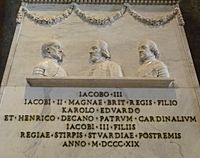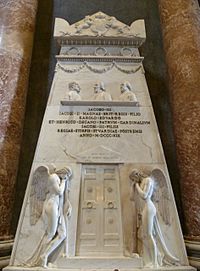Jacobite succession facts for kids
The Jacobite succession is a special idea about who should have been the rightful kings and queens of England, Scotland, and Ireland. It's based on the belief that the throne should pass down through the oldest child, usually the oldest son (this is called primogeniture).
This idea started after King James II and VII was removed from power in 1688. He died in 1701. People who supported the Jacobite succession were called Jacobites. They believed James and his family, the Stuarts, were the true rulers, even though the law said otherwise.
James's family were Roman Catholics. Because of this, the law said they couldn't be king or queen. But James's son, James Francis Edward Stuart (known as the 'Old Pretender'), and his grandson, Charles Edward Stuart (the 'Young Pretender' or 'Bonnie Prince Charlie'), still tried to claim the crowns. They even led rebellions and invasions to get the throne back.
For many years, from 1689 to the mid-1700s, bringing back the Jacobite succession was a big political issue in Britain. Many people supported it, both in Britain and other countries. However, after Charles Edward's big defeat at the Battle of Culloden in 1746, the Jacobite cause lost most of its support and importance.
James II and VII's other grandson, Henry Benedict Stuart, was the last direct descendant of James II. He died in 1807. By then, very few people still supported the Jacobite succession. After Henry died without children, the claim to the throne technically passed to his relatives in other European royal families. However, none of these later heirs ever tried to claim the British throne. Today, only a very small number of people still believe the Jacobite succession should be restored.
Contents
History of the Jacobite Claim
Why James II Lost His Throne
King James II and VII was a Roman Catholic. Many powerful people in England were Protestants and didn't want a Catholic king. In 1688, these opponents forced James to leave England. This event is known as the Glorious Revolution.
The English Parliament decided that by leaving, James had given up his throne. The Scottish Parliament also declared that James had lost his crown because of his actions. Instead of giving the crowns to James's baby son, they offered them to James's adult Protestant daughter, Mary, and her husband, William of Orange. William and Mary then became joint rulers.
New Laws for the Throne
After William and Mary, James's younger daughter, Anne, became Queen in 1702. She was also a Protestant. Before Anne became queen, a very important law was passed called the Act of Settlement 1701. This law was made to make sure that no Catholic could ever be king or queen of England again. It also clearly set out who would inherit the throne if Anne died without children.
The law said that after Anne, the throne would go to Sophia of Hanover and her Protestant descendants. Sophia was a granddaughter of an earlier king, James VI and I. This meant the throne would pass to the Protestant House of Hanover. Sophia died just before Queen Anne, so when Anne died in 1714, Sophia's son, George I, became king. This officially established the Hanoverian line of succession.
Stuarts in Exile and Their Fight
Even after losing their crowns, James II and VII, his son James ('the Old Pretender'), and his grandsons Charles ('the Young Pretender') and Henry never gave up their claim. They continued to try and get the throne back from other countries.
They had supporters, called Jacobites, in England, Ireland, and especially Scotland. The Jacobite claim was a big problem for British politics between 1689 and 1746. There were several uprisings and invasions to support the exiled Stuarts, including major ones in 1689, 1715, 1719, and 1745.
Not many other countries recognized the Jacobite claim. Only France, Spain, and the Papacy (the Pope) recognized James II's son as 'James III' after his father died in 1701. However, France and Spain later stopped supporting the Jacobites. Even the Pope stopped recognizing the Jacobite claim after James, the Old Pretender, died in 1766.
The Jacobite cause suffered a huge defeat at the Battle of Culloden in 1746. After this, it quickly lost its power and importance. When Charles, the 'Young Pretender', died in 1788, the Jacobite claim had almost no political importance left. His younger brother, Henry, died in 1807. With Henry's death, the direct line of the Royal House of Stuart ended. This meant the House of Hanover was firmly established as the only ruling family for the British throne.
Who Came After the Stuarts?
After Henry, the last direct Stuart, died without children, the Jacobite claim technically passed to his closest living relative. This was Charles Emmanuel IV of Sardinia. From him, the claim passed through other European royal families, including the House of Savoy, Austria-Este, and Wittelsbach.
However, none of these later heirs ever tried to claim the British throne. They didn't even use the symbols of England, Scotland, or Ireland on their family crests. Today, there are still a few people who call themselves 'Jacobites', but not all of them want to see the Jacobite succession restored to the throne.
Jacobite Pretenders and Later Heirs
The traditional way of deciding who inherits the throne is called male-preference primogeniture. This means the oldest son inherits first, then other sons, then daughters. The laws passed after the Glorious Revolution changed this to exclude Catholics. However, Jacobites did not accept these new laws.
The tables below show the line of succession as Jacobites believed it should be, following the old rules of primogeniture.
The Stuart Pretenders
These are the members of the Stuart family who claimed the thrones of England, Scotland, and Ireland after 1688:
| Claimant, Lifespan, and Dates of Claim | Portrait | Why They Claimed the Throne |
|---|---|---|
| James II & VII (1633–1701) 11 December 1688 – 16 September 1701 |
 |
James became king after his brother, Charles II, died without children in 1685. When James left the country in 1688, Parliament said he had given up his throne. But James and his supporters said he was still the rightful king. |
| James Francis Edward Stuart (1688–1766) ("James III & VIII") ("The Old Pretender") 16 September 1701 – 1 January 1766 |
 |
When James II & VII died in 1701, his only living son, James, inherited his father's claim. People who didn't support him called him the "Old Pretender." |
| Charles Edward Stuart (1720–1788) ("Charles III") ("The Young Pretender") ("Bonnie Prince Charlie") 1 January 1766 – 31 January 1788 |
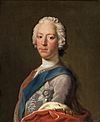 |
After James, the "Old Pretender," died in 1766, Charles, as James's oldest son, took over the claim to the throne. |
| Henry Benedict Stuart (1725–1807) ("Henry IX & I") ("Cardinal Duke of York") 31 January 1788 – 13 July 1807 |
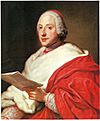 |
Henry was Charles Edward Stuart's only brother. When Charles died in 1788, Henry became the last living direct descendant of James II/VII. The Pope did not recognize his claim. |
Later Heirs to the Jacobite Claim
After Henry, the last Stuart, died, the Jacobite claim passed to other families. However, unlike the Stuarts, none of these people ever tried to become the British monarch.
| Family | Heir, Lifespan, and Dates as Heir | Portrait | How They Were Related to the Previous Heir |
|---|---|---|---|
| Savoy | Charles Emmanuel IV of Sardinia (1751–1818) ("Charles IV") 13 July 1807 – 6 October 1819 |
 |
He was the oldest living descendant of Henry's great-aunt, Henrietta of Orleans. Henry had no children, and no other direct descendants of James II/VII were alive. |
| Victor Emmanuel I of Sardinia (1759–1824) ("Victor") 6 October 1819 – 10 January 1824 |
 |
He was the next oldest brother of Charles Emmanuel, who had died without children. | |
| Maria Beatrice of Savoy (1792–1840) ("Mary II" or "Mary III") 10 January 1824 – 15 September 1840 |
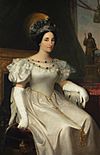 |
She was the oldest living daughter of Victor Emmanuel, who had no living sons. | |
| Austria-Este | Francis V, Duke of Modena (1819–1875) ("Francis I") 15 September 1840 – 20 November 1875 |
 |
He was the oldest son of Maria Beatrice. |
| Maria Theresa of Austria-Este (1849–1919) ("Mary III" or "Mary IV") 20 November 1875 – 3 February 1919 |
 |
She was the niece of Francis, who died without children. She was the only child of Francis's brother, Ferdinand, who had died before Francis. | |
| Wittelsbach | Rupprecht, Crown Prince of Bavaria (1869–1955) ("Robert I & IV") 3 February 1919 – 2 August 1955 |
 |
He was the oldest son of Maria Theresa. |
| Albrecht, Duke of Bavaria (1905–1996) ("Albert") 2 August 1955 – 8 July 1996 |
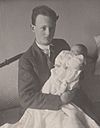 |
He was the oldest living son of Rupprecht. | |
| Franz, Duke of Bavaria (born 1933) ("Francis II") 8 July 1996 – present |
 |
He is the oldest son of Albrecht. |
- The person who would be next in line is the current holder's younger brother, Prince Max, Duke in Bavaria (born 1937).
- Prince Max's next heir would be his oldest daughter Sophie, Hereditary Princess of Liechtenstein (born 1967).
- The next in line after her would be her oldest son Prince Joseph Wenzel of Liechtenstein (born 1995) from the House of Liechtenstein.
- Prince Max's next heir would be his oldest daughter Sophie, Hereditary Princess of Liechtenstein (born 1967).
Family Tree
| Family tree showing the Jacobite line of succession and its relationship to the UK monarchs descended from Sophia of Hanover |
 |
See also


